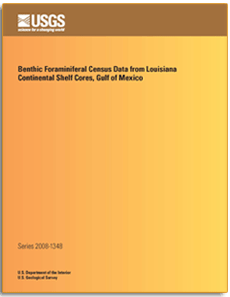Open-File Report 2008–1348

IntroductionAn area of oxygen-depleted bottom- and subsurface-water (hypoxia = dissolved oxygen < 2 mg/L-1) occurs seasonally on the Louisiana Shelf near the Mississippi River. The area of hypoxia, also known as the “dead zone,” forms when spring and early summer freshwater flow from the Mississippi River supplies a large amount of nutrients to the shelf while creating a freshwater lens, or cap, above the shelf water. The excess nutrients cause phytoplankton blooms in the shallow shelf water. After the bloom ceases, the organic material sinks in the water column and uses up oxygen during decomposition. Thus, the subsurface waters become oxygen depleted. The seasonal dead zone exists until a reduction in freshwater flow, or overturning by storms, allows mixing of the water column to restore normal oxygen conditions (Rabalais and others, 1994, 1996; Rabalais, 2002). Since systematic measurement of the extent of the dead zone began in 1985, the overall pattern indicates that the area of the dead zone is increasing (Rabalais and Turner, 2001; Turner and others, 2005). Several studies have concluded that the expansion of the Louisiana Shelf dead zone is related to increased nutrients (primarily nitrogen, but possibly also phosphorous) in the Mississippi River drainage basin and is responsible for the degradation of Gulf of Mexico marine habitats (Goolsby and others, 2001). This paper presents the benthic foraminiferal data from 10 sediment cores collected from the Continental Shelf of Louisiana (table 1), obtained as part of an initiative to investigate the geographic and temporal extent of hypoxia prior to 1985 in the Gulf of Mexico. Benthic foraminifers provide a method to track the development of hypoxia prior to 1985 (Blackwelder and others, 1996; Sen Gupta and others, 1996). Previous work (Osterman, 2003) has shown statistically that the relative occurrence of three low-oxygen-tolerant species represents the modern seasonal Louisiana hypoxia zone. The cumulative percentage of these three species (% Pseudononion atlanticum + % Epistominella vitrea, + % Buliminella morgani = PEB index of hypoxia) provides a way to investigate fluctuation in paleohypoxia. Interpretation of some of these cores is provided in Osterman and others (2005), Osterman and others (2008a,b), and Swarzenski and others (2008). Our hypothesis is that the increased relative abundance of PEB species in dated sediment cores accurately tracks past seasonal low-oxygen conditions on the Louisiana Shelf. |
First posted April 2009 For additional information, please contact: Part or all of this report is presented in Portable Document Format (PDF); the latest version of Adobe Reader or similar software is required to view it. Download the latest version of Acrobat® Reader, free of charge. |
Suggested citation:
Osterman, L.E., Kelly, W.S., and Ricardo, J.P., 2009, Benthic Foraminiferal Census Data from Louisiana Continental Shelf Cores, Gulf of Mexico: U.S. Geological Survey Open-File Report 2008-1348, 16 p.
Introduction
Methods and Materials
Faunal Analysis
Acknowledgments
References Cited
Faunal Reference List